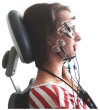Cervical Myofascial Pain Is Associated with an Imbalance of Masticatory Muscle Activity
- PMID: 35162600
- PMCID: PMC8834744
- DOI: 10.3390/ijerph19031577
Cervical Myofascial Pain Is Associated with an Imbalance of Masticatory Muscle Activity
Abstract
This study aimed to assess the relationship between the occurrence of cervical myofascial pain with active myofascial trigger points (MTrPs) within the upper trapezius muscle and the electromyographic asymmetry index (AsI) of masticatory muscles: temporalis anterior (TA), superficial part of the masseter muscle (MM), and anterior belly of the digastric muscle (DA). The study group comprised 100 subjects (80 women and 20 men) aged 18 to 30 years (mean 23 ± 2.6 years) reporting pain in the neck muscles, diagnosed with myofascial pain with active MTrPs only within the upper trapezius muscle. The control group comprised 60 healthy, pain-free subjects (42 women and 18 men) aged 20 to 30 years (mean 22.8 ± 2.6 years) without MTrPs in the upper trapezius muscle. The palpation measurement, based on the diagnostic criteria of Travell and Simons, was used to diagnose active MTrPs. The masticatory muscle activity was recorded using an 8-channel device for surface electromyography-BioEMG IIITM. Significant differences in electromyographic patterns between the group with MTrPs in the right side of upper trapezius muscle and the control group were observed within resting activity for the AsI TA (MTrPs: 8.64 vs. controls: -3.22; p = 0.001) and AsI MM (MTrPs: 7.05 vs. controls: -2.09; p = 0.018). Controls presented different electromyographic patterns during maximum voluntary clenching with cotton rolls between teeth within masseter muscle compared to the MTrPs group (MTrPs: 9.27 vs. controls: -0.43 vs. p = 0.041). Participants with MTrPs in the left side of upper trapezius muscle presented predomination of left-sided electromyographic patterns at rest within temporalis anterior in comparison to controls (MTrPs: -19.22 vs. controls: -3.22; p = 0.001). MTrPs within the trapezius muscle may be related to asymmetry within the masticatory muscle activity, suggesting that the presence of myofascial pain within the cervical muscles plays a role in the imbalance of the stomatognathic system. A unilateral active MTrPs within the trapezius muscle may increase the sEMG activity on the same side of the temporalis anterior and masseter muscles.
Keywords: balance; electromyography; masticatory muscles; myofascial pain; neck muscles.
Conflict of interest statement
The authors declare no conflict of interest.
Figures
Similar articles
-
Electromyographic Patterns of Masticatory Muscles in Relation to Active Myofascial Trigger Points of the Upper Trapezius and Temporomandibular Disorders.Diagnostics (Basel). 2021 Mar 24;11(4):580. doi: 10.3390/diagnostics11040580. Diagnostics (Basel). 2021. PMID: 33805008 Free PMC article.
-
Myofascial trigger points and innervation zone locations in upper trapezius muscles.BMC Musculoskelet Disord. 2013 Jun 8;14:179. doi: 10.1186/1471-2474-14-179. BMC Musculoskelet Disord. 2013. PMID: 23758854 Free PMC article.
-
The Difference in Electromyographic Activity While Wearing a Medical Mask in Women with and without Temporomandibular Disorders.Int J Environ Res Public Health. 2022 Nov 23;19(23):15559. doi: 10.3390/ijerph192315559. Int J Environ Res Public Health. 2022. PMID: 36497634 Free PMC article.
-
Proximal myofascial pain in patients with distal complex regional pain syndrome of the upper limb.J Bodyw Mov Ther. 2019 Jul;23(3):547-554. doi: 10.1016/j.jbmt.2019.02.015. Epub 2019 Feb 21. J Bodyw Mov Ther. 2019. PMID: 31563368 Review.
-
The prevalence of myofascial trigger points in neck and shoulder-related disorders: a systematic review of the literature.BMC Musculoskelet Disord. 2018 Jul 25;19(1):252. doi: 10.1186/s12891-018-2157-9. BMC Musculoskelet Disord. 2018. PMID: 30045708 Free PMC article.
Cited by
-
Are Whiplash-Associated Disorders and Temporomandibular Disorders in a Trauma Related Cause and Effect Relationship? A Review.Medicina (Kaunas). 2023 Aug 17;59(8):1482. doi: 10.3390/medicina59081482. Medicina (Kaunas). 2023. PMID: 37629772 Free PMC article. Review.
-
Estimation of cervicocephalic kinesthetic perception and its correlation with fall risk in adults with diabetes and without diabetes experiencing cervical pain: A comparative study.PLoS One. 2025 Jun 12;20(6):e0323457. doi: 10.1371/journal.pone.0323457. eCollection 2025. PLoS One. 2025. PMID: 40504812 Free PMC article.
-
Cervical Range of Motion Analysis Performed with an Accelerometer: A Study of Intersession Reliability for Dental Practice.Healthcare (Basel). 2023 May 15;11(10):1428. doi: 10.3390/healthcare11101428. Healthcare (Basel). 2023. PMID: 37239714 Free PMC article.
-
Altered muscle recruitment patterns during isometric shoulder abduction in individuals with chronic upper trapezius pain: a cross sectional study.BMC Musculoskelet Disord. 2022 Dec 27;23(1):1131. doi: 10.1186/s12891-022-06030-0. BMC Musculoskelet Disord. 2022. PMID: 36575432 Free PMC article.
-
Effects of combined jaw and cervicoscapular exercises on mouth opening and muscle properties in cervical extension type.Sci Rep. 2025 May 30;15(1):19049. doi: 10.1038/s41598-025-03846-3. Sci Rep. 2025. PMID: 40447683 Free PMC article. Clinical Trial.
References
-
- Alvarez D.J., Rockwell P.G. Trigger Points: Diagnosis and Management. Am. Fam. Phys. 2002;65:653–660. - PubMed
MeSH terms
LinkOut - more resources
Full Text Sources


